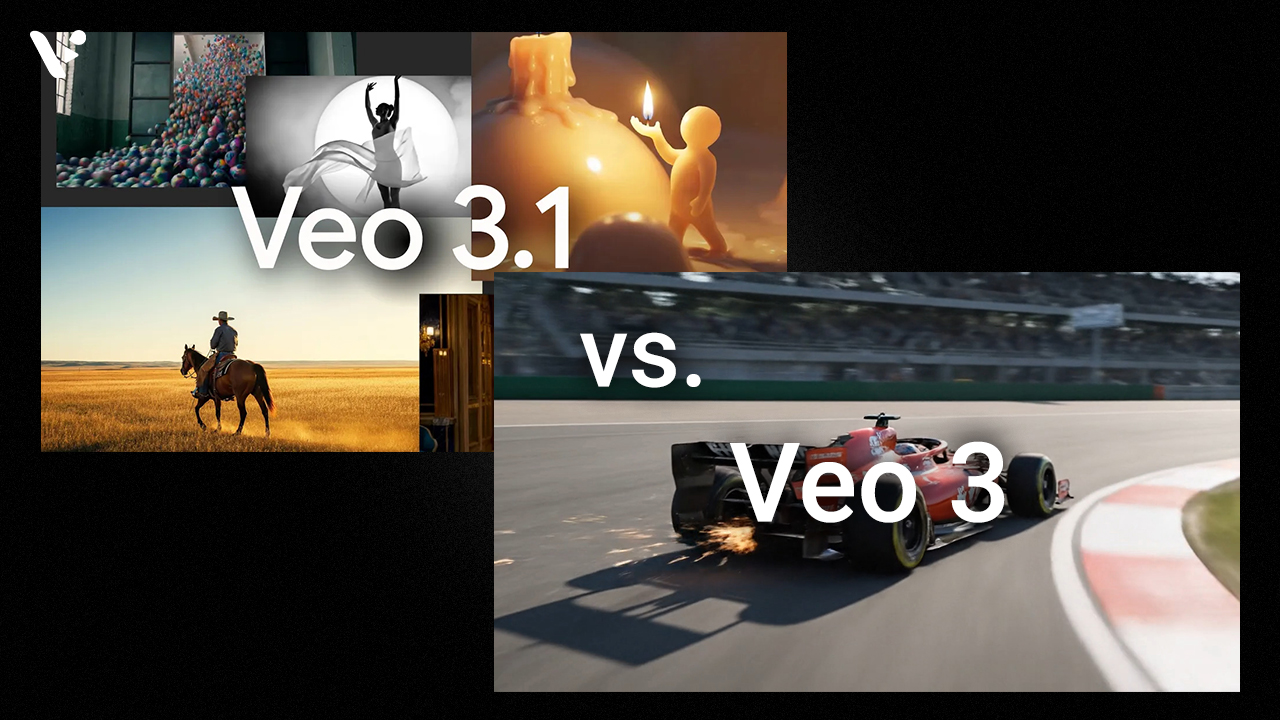What is Veo 3?
Veo 3 is Google’s first widely available release in the “Veo 3” family that made high‑fidelity, short‑form AI video broadly practical. It’s the one you probably tried first: solid, versatile, surprisingly cinematic when you prompt it well.
In plain English:
Veo 3 turns a well‑written prompt into a short (4, 6, or 8‑second) video clip at 720p or 1080p, in either 16:9 or 9:16. It also generates a soundtrack automatically, so you get a clip that already feels like a mini scene—camera moves, lighting, ambience, and basic SFX.
Under the hood (the more technical take):
Veo 3 is a diffusion‑family video generator trained on paired audiovisual data so it can synthesize frames and a matching background sounds from a text description. It conditions on your cinematic instructions (e.g., shot type, motion, lens, style), then rolls out a sequence at a fixed frame rate. Its audio model co‑generates speech/ambience/SFX aligned to the visual beat. In practice, Veo 3 became the dependable baseline for short, prompt‑driven b‑roll, stylized clips, and quick social cuts.
What is Veo 3.1?
Veo 3.1 is the next iteration in the same family. Think of it as Veo 3 with noticeably better taste and control, but not a radical change in what it is and what it can do. If Veo 3 gave you good shots, Veo 3.1 gives you better‑framed, better‑lit, and better‑sounding shots from the same prompt.
In plain English: Veo 3.1 still makes 4–8 second clips at 720p/1080p and 24 fps, but it’s pickier in a good way: it listens more closely to your directions and produces clips with sharper textures, steadier motion, and audio that fits the moment. Dialogue lands more on time, and the overall “feel” is closer to live‑action footage when you ask for realism.
Under the hood (the more technical take): Veo 3.1 refines the video‑and‑audio diffusion stack, improving the model’s prompt adherence, scene comprehension, and audio‑video alignment. It tracks spatial layout and motion cues more faithfully, which shows up as more realistic physics and fewer “mushy” transitions. The audio generator’s timing and timbre match the visuals more reliably, so footsteps, door slams, and line reads line up with what you see. Architecturally, think stronger conditioning and better learned priors rather than a new API surface.
What are the differences between Veo 3 and Veo 3.1?
Short version: the controls are basically the same, but the results (especially realism, motion, and sound) are better in 3.1. Here’s a basic side‑by‑side focused only on base generation.
| Category | Veo 3 | Veo 3.1 | Why it matters |
|---|---|---|---|
| Clip length (base generate) | 4, 6, or 8 seconds | 4, 6, or 8 seconds | Same caps; longer runtimes come from extension workflows, not base generate. |
| Aspect ratios | 16:9, 9:16 | 16:9, 9:16 | Choose horizontal for YouTube/film looks; vertical for Reels/Shorts. |
| Resolution | 720p or 1080p | 720p or 1080p | Same outputs; 1080p is enough for most social + editorial. |
| Frame rate | 24 fps | 24 fps | Filmic cadence stays the default in both. |
| Native audio | Yes | Yes (richer/more precise) | Both generate audio; 3.1’s mix and timing feel more intentional. |
| Prompt adherence | Good | Better | 3.1 follows lens/shot/motion/style directions more tightly. |
| Realism & texture | Good | Better | Surfaces, lighting, and materials look more true‑to‑life in 3.1. |
| Motion & physics | Good | Better | Smoother pans, steadier subjects, more believable physics in 3.1. |
| Audio‑video sync | Good | Better | Dialogue/SFX cues hit closer to the visual moments in 3.1. |
| Outputs per request | Up to 4 | Up to 4 | Same. |
| Throughput caps | Typical fixed quotas | Typical fixed quotas | Same order of magnitude for RPM and parallelism. |
| Stability | GA/stable | Preview (model IDs labeled preview) | 3.1 is still labeled preview as of this writing. |
| Typical use | Reliable b‑roll, quick stylized cuts, animatics | Same use cases but with higher keeper rate on realism and audio | If you noticed “almost there” shots in 3, 3.1 often tips them into “useable.” |
| Price (video+audio) | $0.40/s (Std), $0.15/s (Fast) | $0.40/s (Std), $0.15/s (Fast) | As of Nov 2025, parity. Video‑only tiers cost less. |
So what changed, really?
- Look & feel: With the same prompt, 3.1 tends to yield crisper detail, better lighting balance, and more realistic motion. Skin, fabric, metal, and water pick up subtle texture rather than watercolor smear.
- Listening skills: If you specify a crane shot into a close‑up with a character whispering a line on the push‑in, 3.1 is likelier to obey both the camera note and time the whisper on the beat.
- Fewer retries: Because adherence improves, you spend fewer credits prompt‑massaging the same beat. The keeper rate per prompt goes up.
You can use Veo 3 and Veo 3.1 in Visla
You can run both in Visla. For most teams, that means:
- Veo 3 is available to free users (great for testing ideas and cranking out quick inserts).
- Veo 3.1 is available to paid users and costs more credits per clip (because the underlying model costs more to run). If you’re chasing higher fidelity and better adherence, it’s absolutely worth it.
Once you’ve generated your clips, you can use them in any Visla video project. Our smart AI can take those clips and use them as part of a whole that tells a cohesive story.
How to generate a Veo 3 or 3.1 clip in Visla
- Prompt
Open Visla and click Generate AI Video to open the prompt box. Pick Veo 3 or Veo 3.1 as the model. Write what you want to see and hear clearly. Use cinematic terms and include quoted dialogue, SFX, and ambience if needed. - Settings
Choose the duration (up to 8 seconds per clip) and aspect ratio (16:9 or 9:16) that fit your project. - Generate
Click Generate to create your clip. The clip saves to your Teamspace so you can place it into any Visla project and collaborate with your team.
Prompts that work
Feel feel to copy and paste these prompts and tweak them as needed.
Cinematic realism
“Moving drone shot starting low on a lone hiker walking what seems to be a simple trail and rising high to reveal a gorgeous, lush canyon at sunrise with mist in the air. SFX: soft wind and distant hawks. Ambience: sparse but pulsing ambient running background music”
Interview a-roll
“Locked‑off medium camera shot of a robotics engineer in a sunlit lab, shallow depth of field, gentle rack focus to a robotic arm. Dialogue: ‘We made it smaller and faster this quarter. The gains we’ll get from this change are immense’ Ambience: upbeat background music”
Vertical social
“Shallow depth of field camera shot of a complex, artful latte art pour, bokeh café lights. Ambience: low chatter, espresso hiss, a bit of jazz music.”
FAQ
Veo 3.1 typically produces more faithful, cinematic shots that follow your prompt more closely, with noticeably better text alignment. It also tends to deliver tighter audio‑video synchronization and more convincing motion/physics. In side‑by‑side testing and public benchmarks cited by Google, Veo 3.1 is often preferred for overall realism. If you’re chasing “keeper” takes with minimal retries, 3.1 is the safer bet.
Both models generate short clips at 720p or 1080p in 16:9 or 9:16, and both default to 24 fps. Standard clip lengths are 4, 6, or 8 seconds, with 8 seconds being the most common. A small nuance is that certain 3.1 workflows (like reference‑image video) are fixed to 8 seconds. Otherwise, the core generation specs are effectively the same for everyday use.
Speed depends on the tier you choose rather than the version number. Both Veo 3 and Veo 3.1 come in Standard and Fast variants, and the Fast options trade a bit of fidelity for lower cost and higher throughput. In practice, teams often ideate with Fast and finalize with Standard. If latency matters more than micro‑details, either model’s Fast tier is a smart choice.
Yes. Veo 3 and Veo 3.1 both natively generate audio paired with the video. Veo 3.1 usually produces richer soundscapes and tighter lip‑sync for dialogue. To control audio, write clear lines in quotes for speech, add labels for SFX and Ambient noise, and keep timing cues simple. That structure gives the model the best chance to score and mix the scene the way you intend.
List prices are aligned across versions: the Standard tiers for video‑only and video+audio are the same between Veo 3 and Veo 3.1, and the same is true for the Fast tiers. Because the per‑second rates match, the cost question mostly comes down to retries and your quality bar. If you get a “keeper” in fewer attempts with 3.1, it can be more cost‑effective despite equivalent per‑second pricing. Choose Fast for exploration and Standard for hero shots to keep budgets predictable.

